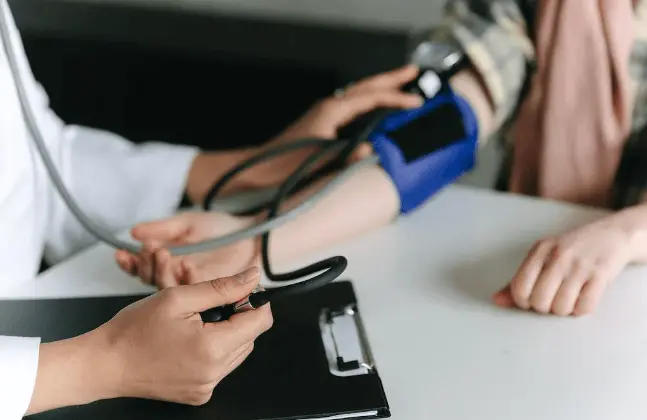Your risk of high blood pressure (hypertension) rises with age, but getting some exercise can help. If you are someone with high blood pressure, exercise can help you control it. Don’t think you have to run a marathon or join a gym right away. Instead, it is better to begin gradually and incorporate more physical activity into your daily routine with time.
Regular physical activity strengthens your heart. A strong and healthy heart is capable of pumping more blood with less effort. As a result, the force on your arteries decreases, resulting in a decrease in blood pressure. Normal blood pressure is 120/80 per mm Hg.
Regular exercise also helps you maintain a healthy weight, which is another important factor in blood pressure control. If you’re overweight, even losing 5 pounds (2.3 kilograms) can help lower your blood pressure.
You should continue to exercise and engage in physical activities on a regular basis to keep your body and blood pressure in control. Regular exercise can take about one to three months to have an effect on your blood pressure.
If you have high blood pressure, you may be wondering if you need medicines to keep your blood pressure under control. However, lifestyle choices can be an important factor in the treatment of high blood pressure. Blood pressure control through a healthy lifestyle may prevent, delay, or reduce the need for medication.
Here are 10 lifestyle changes that can help you lower your blood pressure:
1. Try losing weight and keep a close eye on your waistline.
Being overweight can also result in interrupted breathing while sleeping (sleep apnea), which raises blood pressure even more.
Weight loss is one of the most effective and useful lifestyle changes for blood pressure control. If you are overweight or obese, even losing a small amount of weight can help lower your blood pressure.
The size of the waistline is also important. Carrying excess weight and fat around your waist can increase the risk of hypertension.
Generally speaking:
- Men with a waist circumference exceeding 40 inches are at risk (102 centimetres).
- Women with a waist measurement exceeding 35 inches are at risk (89 centimetres).
These figures differ depending on ethnic group. Inquire with your doctor about a healthy waist measurement for you.
2. Regular exercise
Physical activity on a regular basis can reduce the chance of high blood pressure. It is important to continue exercising to keep blood pressure from rising again. You should aim for moderate physical activities and exercise per day as a general goal.
Regular physical activity can help people with hypertension lower their blood pressure.

Walking, jogging, cycling, swimming, and dancing are some examples of aerobic exercises that can help lower blood pressure. High-intensity interval training is another option. Short bursts of intense activity are alternated with periods of lighter activity in this type of training.
Strength training can also help lower blood pressure. Consult with your doctor about starting an exercise program.
3. Maintain a healthy diet
A diet rich in whole grains, fruits, vegetables, and low-fat dairy products, as well as low in saturated fat and cholesterol, can help to reduce high blood pressure. The Dietary Approaches to Stop Hypertension (DASH) diet and the Mediterranean diet are two examples of eating plans that can help control blood pressure.
Potassium in the diet can help to reduce the effects of sodium (salt) on blood pressure. Foods such as fruits and vegetables are better sources of potassium than supplements.
4. Limit your intake of sodium
Limiting your sodium intake can help to lower blood pressure.
To reduce sodium intake:
- Examine food labels. Look for foods and beverages with low sodium levels.
- Reduce your intake of processed foods. Natural sodium levels in foods are extremely low. The majority of sodium content in food is added during the manufacturing process.
- Cook. Cooking allows you to control the amount of sodium in your diet.
5. Drink in moderation
Limiting alcohol consumption can be helpful in keeping your blood pressure under control.
Excessive alcohol consumption can cause blood pressure to rise by several points. Alcohol consumption can also make blood pressure medication less effective.
6. Give up smoking
Cigarette smoking raises blood pressure. Quitting smoking lowers blood pressure. It can also lower the risk of heart disease and improve overall health, potentially resulting in longer life.
7. Get plenty of rest
Sleep deprivation (less than six hours of sleep per night for several weeks) can contribute to hypertension. Sleep apnea, restless leg syndrome, and general sleeplessness are all conditions that can cause insomnia.
Inform your doctor if you frequently have trouble sleeping. Finding and treating the source of the problem can help you sleep better.

If you don’t have sleep apnea or restless leg syndrome, however, try these simple sleep-improvement tips.
- Maintain a consistent sleep schedule. Every day, go to bed and wake up at the same time. Maintain a consistent schedule on weeknights and weekends.
- Make a relaxing environment. This includes keeping the sleeping area cool, quiet, and dark. In the hour before bedtime, do something relaxing. This could include taking a warm bath or practicing relaxation techniques. Avoid bright light, such as that emitted by a television or computer screen.
- Keep a tab on what you eat and drink. Don’t sleep hungry or stuffed. You should avoid large meals close to bedtime. Limit or avoid nicotine, caffeine, and alcohol before going to bed.
8. Decrease stress
Long-term emotional stress may contribute to hypertension. More research is needed to determine whether stress reduction techniques can lower blood pressure.
However, it can’t hurt to figure out what causes stress, such as work, family, finances, or illness, and then figure out how to deal with it. Consider the following:
- Try not to take on too much. Plan your day and prioritize your tasks. Understand how to say no. Allow enough time to complete the tasks at hand.
- Concentrate on issues over which you have control and devise solutions. Speak with a manager about a problem at work. Find ways to resolve conflicts with your children or spouse.
- Stay away from stressors. Travel at a different time or take public transportation, for example, if rush-hour traffic causes stress. If possible, avoid people who are stressed.
- Make time to unwind. Give yourself time and spend some alone time each day sitting quietly and breathing deeply. Make time for enjoyable activities or hobbies like walking, cooking, and volunteering.
- Exercise gratitude. Gratitude for others can help reduce stress.
9. Keep track of your blood pressure at home and schedule regular checkups.
Home monitoring can assist and help you to keep track of your blood pressure. It can ensure that your medications and lifestyle changes are effective.
Home blood pressure monitors are widely available and do not require a prescription. Before you begin, consult with a health care provider about home monitoring.

Regular visits to a provider are also essential for blood pressure control. If your blood pressure is under control, ask your doctor how frequently you should check it. You might only be able to check it once a day or less.
10. Seek assistance
Family and friends who are supportive are essential for good health. They may encourage you to take care of yourself, drive you to the doctor’s office, or start an exercise program with you to keep your blood pressure under control.
Consider joining a support group if you find yourself in need of assistance outside of your family and friends. This may put you in contact with people who can give you an emotional or morale boost as well as practical coping tips.
Here are some exercises that can help you in lowering blood pressure:
1. Ten minutes of vigorous or moderate walking three times per day
Exercise helps to lower blood pressure, also allowing blood to flow more freely. The effects of exercise are most noticeable during and immediately after exercise. The reduction in blood pressure is most noticeable immediately after exercise.
Exercising in multiple sessions throughout the day can be the best way to combat high blood pressure. In fact, one study discovered that three 10-minute walks per day prevented future blood pressure spikes more effectively than one 30-minute trek per day.
2. 30 minutes of biking or stationary cycling per day, or three 10-minute blocks of cycling
Cycling for a moderate time can help in lowering blood pressure. You can use a stationary bike or a normal cycle and engage in pedaling according to your comfort.
3. Trekking
The muscle power required to climb an incline, hill, or mountain can help you achieve a higher level of fitness. Hiking, for example, can lower blood pressure by up to ten points.
4. Treadmilling or pedal pushing
Blood pressure readings were even better in a study where participants walked at a slow 1-mile-per-hour pace for at least 10 minutes every hour on desk-based treadmills or pedaled stationary bikes under a desk for at least 10 minutes every hour.

5. Strength training
Although it may appear to be counterintuitive, weight training or lifting can lower blood pressure. Strength training temporarily raises blood pressure, but it can improve overall fitness, which in turn improves blood pressure.
6. Swimming
Another study discovered that this type of exercise could help control blood pressure in adults aged 60 and up. Swimmers gradually worked their way up to 45 minutes of continuous swimming at a time over a 12-week period. The swimmers had reduced their systolic blood pressure by an average of nine points by the end of the study.
The benefits of exercise are not realized unless the exercise is sustained, so the ”use it or lose it” theory is correct. Gains can be lost after a two-week break from exercise. The standard recommendation is 150 minutes of moderate exercise per week or 75 minutes of vigorous exercise per week.
In conclusion
The American College of Cardiology recommends that adults engage in 150 to 300 minutes of moderate-intensity aerobic physical activity per week or 75 to 150 minutes of vigorous-intensity activity per week, but any increase in exercise is beneficial.
Combining aerobic workouts with weight training will produce the best results for lowering blood pressure by increasing muscle mass and decreasing body fat.
